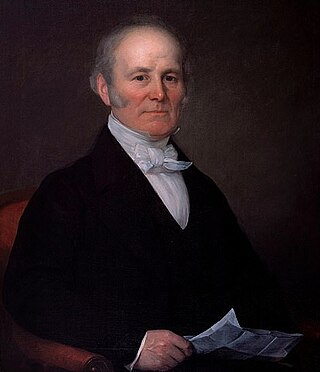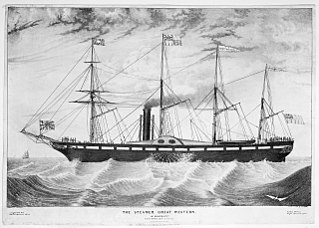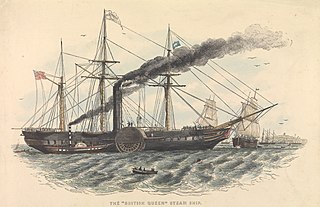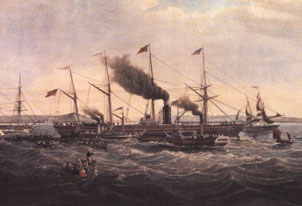
Cunard Line is a British shipping and cruise line based at Carnival House at Southampton, England, operated by Carnival UK and owned by Carnival Corporation & plc. Since 2011, Cunard and its three ships have been registered in Hamilton, Bermuda.

Sir Samuel Cunard, 1st Baronet, was a British-Canadian shipping magnate, born in Halifax, Nova Scotia, who founded the Cunard Line, establishing the first scheduled steamship connection with North America. He was the son of a master carpenter and timber merchant who had fled the American Revolution and settled in Halifax.

A steamship, often referred to as a steamer, is a type of steam-powered vessel, typically ocean-faring and seaworthy, that is propelled by one or more steam engines that typically move (turn) propellers or paddlewheels. The first steamships came into practical usage during the early 1800s; however, there were exceptions that came before. Steamships usually use the prefix designations of "PS" for paddle steamer or "SS" for screw steamer. As paddle steamers became less common, "SS" is assumed by many to stand for "steamship". Ships powered by internal combustion engines use a prefix such as "MV" for motor vessel, so it is not correct to use "SS" for most modern vessels.

The Blue Riband is an unofficial accolade given to the passenger liner crossing the Atlantic Ocean in regular service with the record highest average speed. The term was borrowed from horse racing and was not widely used until after 1910. The record is based on average speed rather than passage time because ships follow different routes. Also, eastbound and westbound speed records are reckoned separately, as the more difficult westbound record voyage, against the Gulf Stream and the prevailing weather systems, typically results in lower average speeds.
Transatlantic crossings are passages of passengers and cargo across the Atlantic Ocean between Europe or Africa and the Americas. The majority of passenger traffic is across the North Atlantic between Western Europe and North America. Centuries after the dwindling of sporadic Viking trade with Markland, a regular and lasting transatlantic trade route was established in 1566 with the Spanish West Indies fleets, following the voyages of Christopher Columbus.

An ocean liner is a type of passenger ship primarily used for transportation across seas or oceans. Ocean liners may also carry cargo or mail, and may sometimes be used for other purposes. Only one ocean liner remains in service today.

SS Great Western of 1838, was a wooden-hulled paddle-wheel steamship with four masts, the first steamship purpose-built for crossing the Atlantic, and the initial unit of the Great Western Steamship Company. She was the largest passenger ship in the world from 1837 to 1839, the year the SS British Queen went into service.
The Collins Line was the common name for the American shipping company started by Israel Collins and then built up by his son Edward Knight Collins, formally called the New York and Liverpool United States Mail Steamship Company. Under Edward Collins' guidance, the company grew to be a serious competitor on the transatlantic routes to the British Cunard shipping company.

SS Pacific was a wooden-hulled, sidewheel steamer built in 1849 for transatlantic service with the American Collins Line. Designed to outclass their chief rivals from the British-owned Cunard Line, Pacific and her three sister ships were the largest, fastest and most well-appointed transatlantic steamers of their day.

British Queen was a British passenger liner that was the second steamship completed for the transatlantic route when she was commissioned in 1839. She was the largest passenger ship in the world from 1839 to 1840, then being passed by the SS President. She was named in honor of Queen Victoria and owned by the British and American Steam Navigation Company. British Queen would have been the first transatlantic steamship had she not been delayed by 18 months because of the liquidation of the firm originally contracted to build her engine.

SS Sirius was a wooden-hulled sidewheel steamship built in 1837 by Robert Menzies & Sons of Leith, Scotland for the London-Cork route operated by the Saint George Steam Packet Company. The next year, she opened transatlantic steam passenger service when she was chartered for two voyages by the British and American Steam Navigation Company. By arriving in New York a day ahead of the Great Western, she is usually listed as the first holder of the Blue Riband, although the term was not used until decades later.

The Great Western Steam Ship Company operated the first regular transatlantic steamer service from 1838 until 1846. Related to the Great Western Railway, it was expected to achieve the position that was ultimately secured by the Cunard Line. The firm's first ship, Great Western was capable of record Blue Riband crossings as late as 1843 and was the model for Cunard's Britannia and her three sisters. The company's second steamer, the Great Britain was an outstanding technical achievement of the age. The company collapsed because it failed to secure a mail contract and Great Britain appeared to be a total loss after running aground. The company might have had a more successful outcome had it built sister ships for Great Western instead of investing in the too advanced Great Britain.
The Liverpool and Great Western Steamship Company, known commonly as the Guion Line, was a British passenger service that operated the Liverpool-Queenstown-New York route from 1866 to 1894. While incorporated in Great Britain, 52% of the company's capital was from the American firm, Williams and Guion of New York. Known primarily for transporting immigrants, in 1879 the line started commissioning Blue Riband record breakers to compete against Cunard, White Star and Inman for first class passengers. The financial troubles of one of the company's major partners in 1884 forced the firm to return its latest record breaker, the Oregon, to her builders and focus again on the immigrant trade. The company suspended sailings in 1894 because of new American restrictions on immigrant traffic.

SS Baltic was a wooden-hulled sidewheel steamer built in 1850 for transatlantic service with the American Collins Line. Designed to outclass their chief rivals from the British-owned Cunard Line, Baltic and her three sister ships—Atlantic, Pacific and Arctic—were the largest, fastest and most luxurious transatlantic steamships of their day.

Scotia was a British passenger liner operated by the Cunard Line that won the Blue Riband in 1863 for the fastest westbound transatlantic voyage. She was the last oceangoing paddle steamer, and as late as 1874 she made Cunard's second fastest voyage. Laid up in 1876, Scotia was converted to a twin-screw cable layer in 1879. She served in her new role for twenty-five years until she was wrecked off of Guam in March 1904.

Persia was a British passenger liner operated by the Cunard Line that won the Blue Riband in 1856 for the fastest westbound transatlantic voyage. She was the first Atlantic record breaker constructed of iron and was the largest ship in the world at the time of her launch. However, the inefficiencies of paddle wheel propulsion rendered Persia obsolete and she was taken out of service in 1868 after only twelve years. Attempts to convert Persia to sail were unsuccessful and the former pride of the British merchant marine was scrapped in 1872.

The Britannia class was the Cunard Line's initial fleet of wooden paddlers that established the first year round scheduled Atlantic steamship service in 1840. By 1845, steamships carried half of the transatlantic saloon passengers and Cunard dominated this trade. While the units of the Britannia class were solid performers, they were not superior to many of the other steamers being placed on the Atlantic at that time. What made the Britannia class successful is that it was the first homogeneous class of transatlantic steamships to provide a frequent and uniform service. Britannia, Acadia and Caledonia entered service in 1840 and Columbia in 1841 enabling Cunard to provide the dependable schedule of sailings required under his mail contracts with the Admiralty. It was these mail contracts that enabled Cunard to survive when all of his early competitors failed.

The America class was the replacement for the Britannia class, the Cunard Line's initial fleet of wooden paddle steamers. Entering service starting in 1848, these six vessels permitted Cunard to double its schedule to weekly departures from Liverpool, with alternating sailings to New York. The new ships were also designed to meet new competition from the United States.

SS President was a British passenger liner that was the largest ship in the world when she was commissioned in 1840, and the first steamship to founder on the transatlantic run when she was lost at sea with all 136 onboard in March 1841. She was the largest passenger ship in the world from 1840 to 1841. The ship's owner, the British and American Steam Navigation Company, collapsed as a result of the disappearance.

This is a timeline of the world's largest passenger ships based upon internal volume, initially measured by gross register tonnage and later by gross tonnage. This timeline reflects the largest extant passenger ship in the world at any given time. If a given ship was superseded by another, scrapped, or lost at sea, it is then succeeded. Some records for tonnage outlived the ships that set them - notably the SS Great Eastern, and RMS Queen Elizabeth. The term "largest passenger ship" has evolved over time to also include ships by length as supertankers built by the 1970s were over 400 metres (1,300 ft) long. In the modern era the term has gradually fallen out of use in favor of "largest cruise ship" as the industry has shifted to cruising rather than transatlantic ocean travel.




















